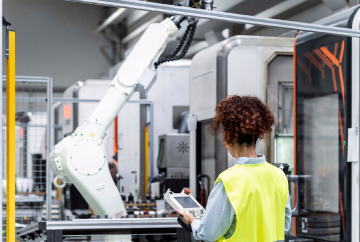Overview
Cement plants across the globe have been undergoing numerous transformations as a part of the Industry 4.0 revolution. Being an asset-intensive manufacturing operation, cement production can benefit from digital technologies in several areas, spanning maintenance and repair operations (MRO), operations optimization, supply chain (SC) processes, and worker health and safety, to name a few.
In the backdrop of this industry-wide transformation, one of the leading cement manufacturers with the largest gray cement, white cement, and ready-mix concrete manufacturing capacity, was facing numerous challenges that can be addressed by Industry 4.0 technologies. At cement plants, across these areas of operations, our client lacked visibility into cement production processes, cement quality, and SC operations. Moreover, they were experiencing unplanned machine downtime which negatively impacted their competitiveness in global markets.
To mitigate these challenges, the client engaged Birlasoft to transform its cement production facilities into cement factories of the future. Birlasoft brings deep expertise into digital transformation programs for the cement industry. When the engagement started, Birlasoft mobilized this expertise to deliver a comprehensive solution that offered real-time prescriptive recommendations for operational optimization and machine upkeep. This helped the client maximize their business performance and productivity, and monitor energy consumption to keep them within specified limits. Read the detailed aspects of this engagement below.
Key Challenges
1. Lack of visibility into material and energy consumption in cement production processes
The life cycle of cement plant assets often spans multiple decades. Over the course of their service, these assets have been controlled with legacy systems, which offer little insight into crucial production metrics. For instance, monitoring energy consumption at a plant level proves challenging, because the machines used in the plants do not come with such built-in capabilities. Moreover, most plants still employ paper-based, or manual digital processes to track material consumption in cement production.
However, the inability to track these crucial consumption metrics in real-time covers up the inefficiencies in the underlying processes. Overconsumption can start becoming a significant cost issue, especially with the increased cost of energy and wastage of material. All of these factors put cement manufacturers at a competitive disadvantage. That’s why our client wanted to build visibility into their material and energy consumption with sensor technology and automation.
2. Need for the capability to predict cement quality during production
Cement manufacturing is a chemically complex process and large-scale production calls for highly calibrated processes and consistent raw material quality. The type and quality of limestone, clay, and other additives will have a significant impact on the end product, as will the pressure, humidity and temperature at various stages, and duration of the kiln process. Because cement particle size distribution affects its performance in construction, achieving consistent quality is crucial to prevent quality-related SC events and to ensure customer satisfaction.
Until recently, cement plants employed manual processes to monitor cement quality. However, more recently, it has become possible to predict cement quality with novel sensor technology and machine learning. Our client wanted to gain insights into cement quality through its production processes to achieve the benefits of such a capability – i.e., the output of consistent quality cement, optimal processes that result in minimal waste, and improved customer outcomes.
3. Plant outages resulting from unplanned machine downtime impeding production
In the cement industry, a single day of unexpected plant outage can cost average manufacturers as much as $300,000. This number can be even higher for larger-scale cement factories, and the cost of downtime has been on the rise in recent years. Being an industry that relies on several machines and fixed assets to enable production, cement manufacturing requires highly efficient machine upkeep processes.
Preventive maintenance strategies can lead to over-maintenance, and reactive maintenance causes unexpected shutdowns. Predictive maintenance is therefore the most optimal maintenance strategy in cement factories. However, implementing it can prove challenging when the assets employed in the cement plants are decades old. Such machines seldom have the interfaces to connect with modern systems.
Our client was facing unexpected plant shutdowns resulting from failures and breakdowns of critical assets. To mitigate this issue, they wanted to implement a predictive maintenance solution and achieve better plant availability.
4. Lack of visibility into key supplier and customer processes causing suboptimal supply chain operations
Finally, our client was facing SC issues due to a lack of visibility into key supplier processes, which were impacting downstream operations. Lack of visibility into supplier processes can result in supply interruptions, variations in raw material quality, and cost fluctuations – all of which impact production quality and efficiency. Moreover, this lack of visibility results in suboptimal inventory management, and inefficient production schedules. The latter may result in more frequent machine breakdown, which in turn, results in higher MRO costs.
At the heart of these issues are data silos in which key information regarding customer and supplier processes resides. Moreover, manual data handling leads to low efficiency, and teams end up playing catch-up to gain insights into the flow of materials across the SC. Our client wanted to gain visibility into SC processes to improve operations, achieve better quality control, and achieve better customer outcomes.
Birlasoft Solution
The client engaged Birlasoft to transform its cement production facilities into factories of the future. Birlasoft deployed its team of experts in the digital transformation of cement manufacturing, to build a self-learning and autonomous solution that would provide descriptive and prescriptive insights into production, MRO, and SC processes. Read the details of this solution below, and how it enabled the client to address the above challenges.
1. Intelligent feedback control system based on adaptive and autonomous models
While building real-time monitoring capabilities for cement plants is a relatively simple task, turning this stream of information into insights proves quite challenging. This is because cement production entails complex processes in which numerous machines operate in tandem to process materials through various stages. Gaining context and making process-level recommendations for optimization therefore becomes a sophisticated machine learning problem.
Birlasoft has deep insights into various cement production models and has built digital twin solutions for cement production facilities. In this engagement, the Birlasoft team built a self-learning and autonomous solution that comprises various models that interact with each other to infer context and deliver prescriptive recommendations at various levels. For instance, to deliver recommendations for performance optimization, an autosteer prescription model delivers automated feedback to the process optimizer, regulator control, and advanced process control modules of the solution.
A sophisticated machine learning architecture enables the client to turn data streams representing complex machine-level interactions across the plant into critical insights. These insights enable operators to make crucial interventions to improve plant outcomes.
2. Real-time process visibility and prescriptive recommendations for performance optimization
The solution deployed by Birlasoft helped the client gain real-time visibility into crucial processes, like pyro processing, and kiln and crusher control processes. For instance, plant operators across facilities could now get performance optimization recommendations to improve crusher control processes based on feed rates and power consumption trends. Similarly, by inferring gas compositions, temperature profile, and other parameters of the kiln, the solution could deliver recommendations to adjust burner settings, modify air flows, and optimize the fuel mix to achieve better outcomes.
Mill processes can also be optimized by adjusting the load of grinding media, altering speed, and other mill parameters based on real-time motor power, and particle and size distribution data. By optimizing these critical processes, the client could not only achieve more stable production processes but also realize optimal performance across their cement plants. The solution deployed by Birlasoft leveraged a human-in-the-loop process to translate the insights delivered by the solution into plant-level actions. The scope of impact for large-scale manufacturers can be significant – performance optimization means lower energy and material waste, improved product quality, enhanced production schedules, and improved RoI on plant assets.
3. Proactive machine monitoring for predictive maintenance of assets
Predictive maintenance is one of the highest-impact applications of AI in the cement industry. It enables plant operators to schedule machine maintenance based on accurate forecasts of when a machine is likely to break down. With forecasts for multiple assets across the plant, operators can schedule maintenance in a way that maximizes plant availability while preventing an unexpected failure.
Birlasoft’s intelligent solution delivered prescriptive recommendations regarding machine maintenance and repair. These recommendations were based on machine health status inferred through proactive, real-time monitoring of key assets like cement kiln, crusher, and mill. In addition to recommendations for maintenance activity scheduling, the solution also recommended real-time preventive actions to keep the assets running within optimal conditions.
4. Capability to monitor and predict cement quality during production
Cement quality prediction not only requires insights into raw material composition but also deep visibility into the production processes. This is because the slightest variations in production processes can strongly affect the quality of the end product. Because the client now had visibility into key processes like kiln temperature and grinding time in the mill, this could be supplemented with raw material composition data to predict cement quality.
Moreover, these predictions could be fed back to the solution to make recommendations for optimizing processes – with the end goal of achieving consistent quality end product. The quality predictions can also be validated with the output product to autocorrect and optimize the predictive quality models. With this solution in place, the cement manufacturer was able to produce consistent quality cement from across its production facilities.
5. Energy consumption monitoring and visibility into supplier and customer processes
Finally, the solution enabled the client to track energy consumption and electricity costs across its cement factories. In some countries, regulators place cement manufacturers under strict scrutiny to curb their GHG emissions. Non-renewable energy consumption forms a significant percentage of Scope 3 GHG emissions for cement manufacturers. With the capability to monitor energy consumption, the client can now stay within the specified limits for GHG emissions in its areas of operation.
Moreover, with visibility into supplier and customer processes, the client could now make meaningful interventions to optimize their SC efficiency.
Key Business Benefits/Impact
With this engagement, Birlasoft transformed the client’s cement plants into factories of the future. Enabled with real-time visibility and prescriptive recommendations for its cement plants, the client realized the following benefits through this engagement:
1. Improved business performance with highly optimized operations
The performance improvements delivered by the solution resulted in a multiplier effect, resulting in highly optimized cement production operations across all cement plants. This enabled improved business performance for the client and made a positive impact on the bottom line.
2. Improved machine uptime with predictive maintenance
The predictive maintenance solution eliminated unplanned downtime and maximized the uptime for critical assets. This resulted in improved plant availability, which enhanced the production capacity and mitigated lost revenues linked to downtime.
3. Enhanced quality control with predictive cement quality capability
With real-time visibility into production processes, the client could now monitor and predict the quality of cement produced. This enabled better quality control and improved customer outcomes.
4. Lower electricity costs enabled by energy consumption monitoring
With the capability to monitor energy consumption at the plant level, the client was able to mitigate energy wastage and lower the expense of electricity at its cement plants.
5. Increased plant productivity and process-level efficiency
Finally, the recommendations delivered by the solution enabled the client to realize significant productivity gains throughout its scope of operations, and increased process-level efficiency. This reduced material wastage and brought significant cost savings for the client.
The cost for alternative fuel consumption was optimized by recommending the right mix of AFR (Coal, Bio-waste, agro waste, tyres etc.) to optimize calorific value and specific heat consumptions.
The cost for alternative fuel consumption was optimized by recommending the right mix of AFR (Coal, Bio-waste, agro waste, tyres etc.) to optimize calorific value and specific heat consumptions.

